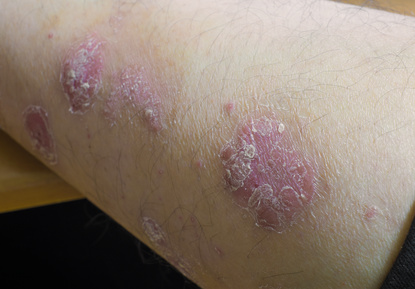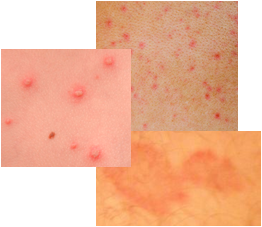Psoriasis Information
Visit this
PICTURES OF RASHES PAGE
Psoriasis information on the symptoms that are associated with the several different forms of this skin disease are provided below. Some diseases such as eczema, lupus, syphilis, and some types of skin cancer can be confused with psoriasis. Therefore, it is important to know the different types, the symptoms, and the causes for each.
Plaque Psoriasis (Psoriasis Vulgaris)

Plaque psoriasis is the most common form of the disease and accounts for 80 percent of all the psoriasis cases. Psoriasis information for this type are distinct patches or large areas of dry skin that are raised and thick (plaques) and covered with silvery-white scales. The surface scales flake off easily, but ones deeper in the skin stick together. Soreness and itch are usually present.
The commonly affected areas by these psoriasis symptoms include the knees, elbows, chest, lower back, palms of the hands, soles of the feet, and the scalp. In severe cases, the skin around the joints will crack and bleed. This skin problem may also affect the sensitive areas of the body such as the genitals and inside of the mouth and may also affect the fingernails and toenails. Changes in nails include pitting, thickening, yellowing or opaque appearance, ridges, and a scaly appearance.
The onset of this condition is marked by itch or a burning sensation may be present. This is followed by the appearance of small red bumps, which gradually become larger and form scales.
Psoriasis Information on Guttate Psoriasis
Guttate psoriasis is the second most common type of psoriasis with 10 percent of the suffers of psoriasis having it. It usually affects individuals younger than 30 years old. It tends to be triggered within a few days from the start of bacterial infections such as strep throat or from other problems such as a cold, tonsillitis, chicken pox, or skin injury. It may also develop as a result of taking certain medications.
Psoriasis information on the symptoms of guttate psoriasis are the appearance of small, drop shaped sores covered with a thin fine scale on the trunk, arms, legs, and sometimes on the scalp, face, and ears. It can be a one-time outbreak that disappears on its own, or can reoccur with repeated infections. Reappearance later in life manifests itself as the plaque type of psoriasis.
Pustular Psoriasis
This form of psoriasis is fairly rare since less than five percent of psoriasis sufferers have this type. When it does occur, it develops quickly and mainly affects adults. The symptoms for pustular psoriasis can include patches all over the body (generalized) or in smaller areas (localized) on the hands, feet or fingertips.
The psoriasis symptoms for the localized version include sore red skin that is swollen and has pus-filled lesions which dry after a couple of days, but may reappear every few days or weeks. Scale or brown dots are usually left behind. The generalized version is rare and severe. It can be life-threatening for older adults and is often triggered by infection such as strep throat, suddenly stopping a steroid medication, lithium medications, or pregnancy. Large areas of red and swollen skin with white pus-filled blisters characterize the generalized version. Fever, chills, severe itching, weight loss, anemia, and fatigue are all possible side effects of the generalized condition.
Inverse (Skin-Fold, Flexural, Genital) Psoriasis
This type is not very common. The symptoms for inverse psoriasis are smooth patches of red, tender and inflamed skin. The main body areas affected are the armpits, groin, under the breasts, between the buttocks, and around the genitals. It is more prevalent in individuals who are overweight and friction and sweating can promote this condition. Inverse psoriasis can be quite severe and incapacitating.
Erythrodermic (Exfoliative) Psoriasis
This is perhaps the least common type of psoriasis. It is a life-threatening condition because skin loses its ability to protect the body either by not preventing heat and fluid loss or by not preventing bacteria from entering the body. Hospitalization is usually required. The psoriasis symptoms for this rare form are that the whole body may be affected with a red, peeling rash that can itch and burn significantly. In fact the skin takes on a burned appearance.
Erythrodermic psoriasis can be caused by overexposure to the sun, use of corticosteroids and other medications, infections, stress, alcoholism, lithium containing medications, anti-malarial drugs or by another type of psoriasis that is not properly controlled.
Psoriatic Arthritis Psoriasis Symptoms
Psoriatic arthritis is a condition that may be associated with this skin problem and starts to develop in the 30 to 50 year old age group. Between 10 and 30 percent of people with psoriasis will develop the psoriasis symptoms such as inflammation of their joints, which can range from mild to severe. It may also lead to conjunctivitis (redness and swelling of the eyelid, also known as “pink eye”).
More psoriasis information can be found below:
psoriasis | causes | treatment
